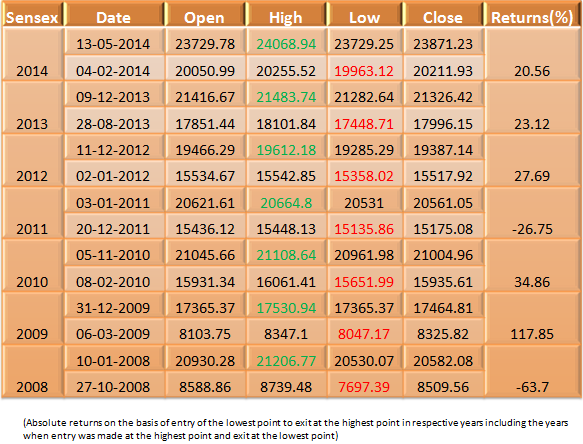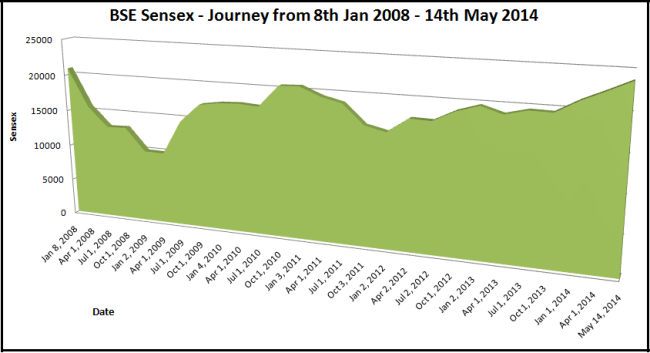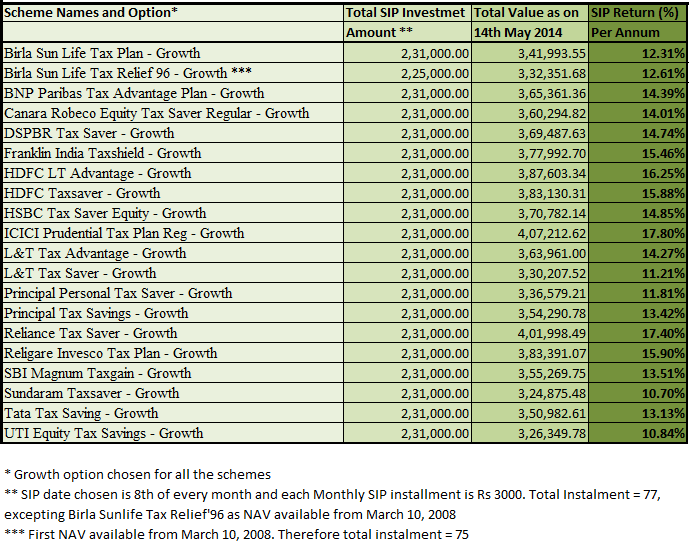How your ELSS SIPs have done from one bull market peak to another

Yesterday we did a similar article From one market peak to another: How your SIPs are doing requested by some of our advisor friends. In the last article we covered SIP returns of some popular open ended schemes across various fund houses and found that even though they were started exactly on the day of the last BSE Sensex peak of 2008, they have done extremely well till May 13, 2014 when we hit the new bull market peak. We found that the investors made positive returns in each of the schemes as they were able to average out the NAV significantly during this volatile period. The annualised returns varied from 11.49% - 18.68% which clearly beaten the inflation and thus real returns were much higher than bank fixed deposits and/or recurring deposits.
Today, we will try to analyse the Equity Linked Savings Scheme SIPs, popularly known as ELSS and analyze how they did during the period of last bull market peak of 2008 to the current peak. But, let us first see how volatile BSE Sensex was during this period –

As you can see the period was extremely volatile. Year 2008 gave the worst negative return of 63.70%, 2011 too gave a negative return of 26.75%. While 2009 gave the highest return of 117% from the lowest point to the highest point during the year, the year 2010, 2012, 2013 and 2014 gave 34.86%, 27.69%, 23.12 % and 20.56% returns respectively.
(We have taken the lowest point for entry and highest point for exit. However, in two cases we had to take highest point at entry and the lowest in exit)
Let us now see the journey of BSE Sensex during the period through the following graph –

Download BSE historical data from Jan 10, 2008 – May 14, 2014 -
It is therefore, clearly understandable that it is impossible to enter at the bottom and exit at the top. Therefore, the only solution to create long term wealth is to invest through Mutual Fund SIPs and continue to do so even if the markets are not doing well. Let us now examine how the ELSS SIPs did during this historical volatile period of Indian stock markets. Please note that we have evaluated the returns of majority of the ELSS Schemes and therefore it can be considered as an exhaustive list. The first SIP instalment date for all schemes have been taken as Jan 8, 2018 (the last bull market BSE Sensex closing peak of 20,873.33) and the last instalment date as May 8, 2014. All the returns are calculated as on May 14, 2014.
RETURNS AS ON MAY 14, 2014 OF ELSS SIPs STARTED ON 8TH JAN 2008

As you can see the investors have made positive returns in each of the above ELSS schemes as they were able to average out the NAV during this extremely volatile period. The annualised returns ranged between 10.70% - 17.80% which clearly beats the inflation; therefore, the real return is also positive. You will also notice that the returns are much higher than bank fixed deposit or recurring deposits. Another two points to be noted here are 1) Long term capital gains from ELSS or for that matter Equity Mutual Funds are tax free 2) By investing in SIPs of ELSS schemes the investor is also getting tax benefits under section 80C.
Key points from the above analysis –
- It is impossible to time the market and thus the benefits of investing through Mutual Fund SIPs or ELSS SIPs works in your favour always, if you are investing for the long term.
- Do not have a fear that the market is going up and you are accumulating units at higher NAVs and when it goes down do not fear that it can go down further.
- By stopping a SIP when the market goes down, you are actually losing out on the opportunity of rupee cost averaging. Remember, you accumulate units at low NAV when markets are not in your favour but also that these NAVs gets appreciated significantly when the market turns around.
- Restarting the SIP when the market settles or reaches the bottom is almost impossible as you cannot time the market.
- Stays invested for the long term and ride the volatility. The classic example is Berkshire Hathaway Inc which believes that the holding period of equity investment could even be forever (“Our favourite holding period is forever” – Warren Buffett) and thus it became the ‘Most expensive stock in the world’
Conclusion – The above proves that if you are investing for the long term wealth creation then you need not waste your time watching the markets or even try timing it. Investing in a good ELSS fund through SIP not only provide tax benefit under section 80C but is also the proven and time tested investment for creating long term wealth to meet your various financial planning goals. The levels of market should not be the criterion for investing in ELSS SIPs.
However, based on your risk taking appetite and the time by which you want to reach a particular goal you should select an appropriate ELSS fund for starting a SIP. Please consult your financial advisor who may help you suggest one or more schemes.
Disclaimer – the above ELSS schemes are almost an exhaustive list of funds offered by leading AMCs in India. But, there could be some more funds which are giving better returns and may not be covered in the above list. Please also note that the above examples of past performance of respective ELSS schemes are not indicative of their future returns. For selecting a suitable ELSS scheme for you, please consult your financial advisor. You may also refer our section on Articles about ELSS for your knowledge.
Queries
-
What is the benefit of mutual fund STP
Aug 29, 2019
-
How much to invest to meet target amount of Rs 2 Crores
Aug 26, 2019
-
Can I achieve my financial goals with my current mutual fund investments
Aug 24, 2019
-
Can you tell me return of various indices
Aug 19, 2019
-
What would be the post tax return on different investments
Aug 18, 2019
-
Which Principal Mutual Fund scheme will be suitable for my retirement corpus
Aug 16, 2019
-
What is the minimum holding period for availing NCD interest
Aug 4, 2019
Top Performing Mutual Funds
Recommended Reading
Fund News
-
The Wealth Company Mutual Fund launches The Wealth Company Gold ETF FOF
Jan 9, 2026 by Advisorkhoj Team
-
Mahindra Manulife Mutual Fund launches Mahindra Manulife Innovation Opportunities Fund
Jan 9, 2026 by Advisorkhoj Team
-
Jio BlackRock Mutual Fund launches Jio BlackRock Short Duration Fund
Jan 8, 2026 by Advisorkhoj Team
-
Jio BlackRock Mutual Fund launches Jio BlackRock Low Duration Fund
Jan 8, 2026 by Advisorkhoj Team
-
Groww Mutual Fund launches Groww Small Cap Fund
Jan 8, 2026 by Advisorkhoj Team














